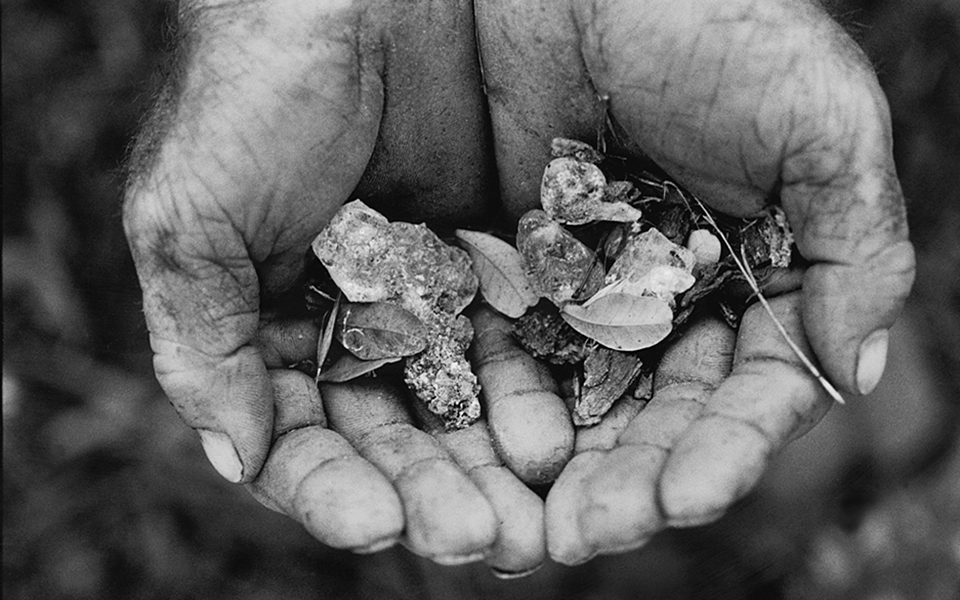Every autumn in the mastichochoria (‘mastic villages’) of Chios, women can be seen sitting on benches in front of the tightly packed stone houses for a task inextricably linked with life on the island’s southern slopes.
They are cleaning mastic, an aromatic resin obtained from the Lentisk tree and the life-blood of these villages since the Middle Ages.
Strong bonds are forged during the cleaning process as women move from house to house helping each other with the work that takes until January to complete. It is a delicate task as each ‘tear’ of mastic must be cleaned individually by hand. The purity of the mastic each producer delivers to the Chios Gum Mastic Growers Association will determine how much they are paid.
While lentisk trees grow in many areas in Greece, it is only on Chios that there is a large-scale production of mastic. The lentisks here are unique, belonging to a strain that is endemic to the island (Pistacia lentiscus var. Chia). For millenia these trees have shaped the domestic, residential and economic structures of the mastichohoria, and they continue to do so today.

© Museum Network of the Piraeus Bank Group Cultural Foundation

The History of Mastic
It was under the rule of the Genoese (1304–1566) that the production of mastic was first systematized. They provided the native Chiots with protection from pirates in exchange for a monopoly on the mastic trade. The densely populated villages were surrounded by walls with gates that would open in the morning to allow villagers to head to the fields and close again at night.
In the center of every village stood a stone tower that was the central storehouse for the mastic as well as the main administrative building. The basic units of production were the homes of the villagers themselves: on the ground floor animals were kept that were used mainly for transport. Above was a floor on which family life played out, while the roof was used for the drying of grain and other agricultural products that formed the basis of the villagers’ diet.
Life was not easy and space was at a premium: every home housed more than one family and there were no courtyards and few free spaces. Every aspect of life revolved around the production of mastic.
In the 16th century Chios passed under Ottoman control. The new rulers kept a monopoly on the trade of mastic until 1840 when Chiots were permitted to sell mastic themselves with the Ottomans collecting a tax on the trade. The 19th century was a particularly difficult period as the value of mastic fell, threatening the industry. As a result Chios Gum Mastic Growers Association was established in 1938 for growers to pool resources. To this day it is the sole body managing the Chios mastic trade.

© Chios Mastiha Growers Association

© Chios Mastiha Growers Association
Cultivation
The method of mastic production has changed little since the Middle Ages, a fact which contributed to UNESCO’s 2014 decision to include Chios’s knowledge of mastic cultivation in its ‘List of the Intangible Cultural Heritage of Humanity‘.
To collect the valuable resin, growers scar the bark of the tree at specific times and using a specific method. In response the tree produces the resin in an effort to heal the wound. The resulting ‘tears’ are collected in the early morning cool before the heat of the day softens them. The ‘tears’ are then transported to the village where they are processed and cleaned before being delivered to the association.
Chios Mastic Museum
At the Chios Mastic Museum, founded just last year, in an attractive modern building in the Mastichohoria region, one can live and breathe the region’s intimate relationship with the valuable and curative resin.
Walking in, you are immediately engulfed by the aroma of the resin and hear a female grower singing a capella the ‘Schiniatikos‘ – a song dedicated to the arduous work of mastic harvesting.
The museum’s first section is dedicated to mastic cultivation, with tools, traditional dresses, videos and an impressive collection of black-and-white photographs of growers in times past juxtaposed with pictures of modern growers to emphasize the timelessness of mastic cultivation in Chios.

© Museum Network of the Piraeus Bank Group Cultural Foundation
Moving on, a winding network of corridors inspired by the densely packed mastichochoria, features exhibits that take one from the Byzantine era to 1912 when Chios became part of the Greek state.
A third section focuses on the modern history of mastic cultivation. Here original equipment from the first factory opened by the Mastic Grower’s Association can be seen in action. In the 1960’s a novel product is created based on mastic resin: chewing gum.
The journey ends with a visit to a grove of cultivated lentisk trees located on the slopes under the museum. The trees change with the season: in the winter they are cut back, while in the summer they are scarred and ‘weeping’.
In the oral history part of the museum, one grower is recorded saying, “The life of a Mastichochorian begins to merge with the mastic itself. Many, during the harvest season, avoid cleaning their hands, while others deliberately cover them in mastic in order – so it is said – to show that they are mastic growers – it is a boast for them.”
The Chios Mastic Museum is part of the Museum Network of the Piraeus Bank Group Cultural Foundation. For opening times and more information click here.












